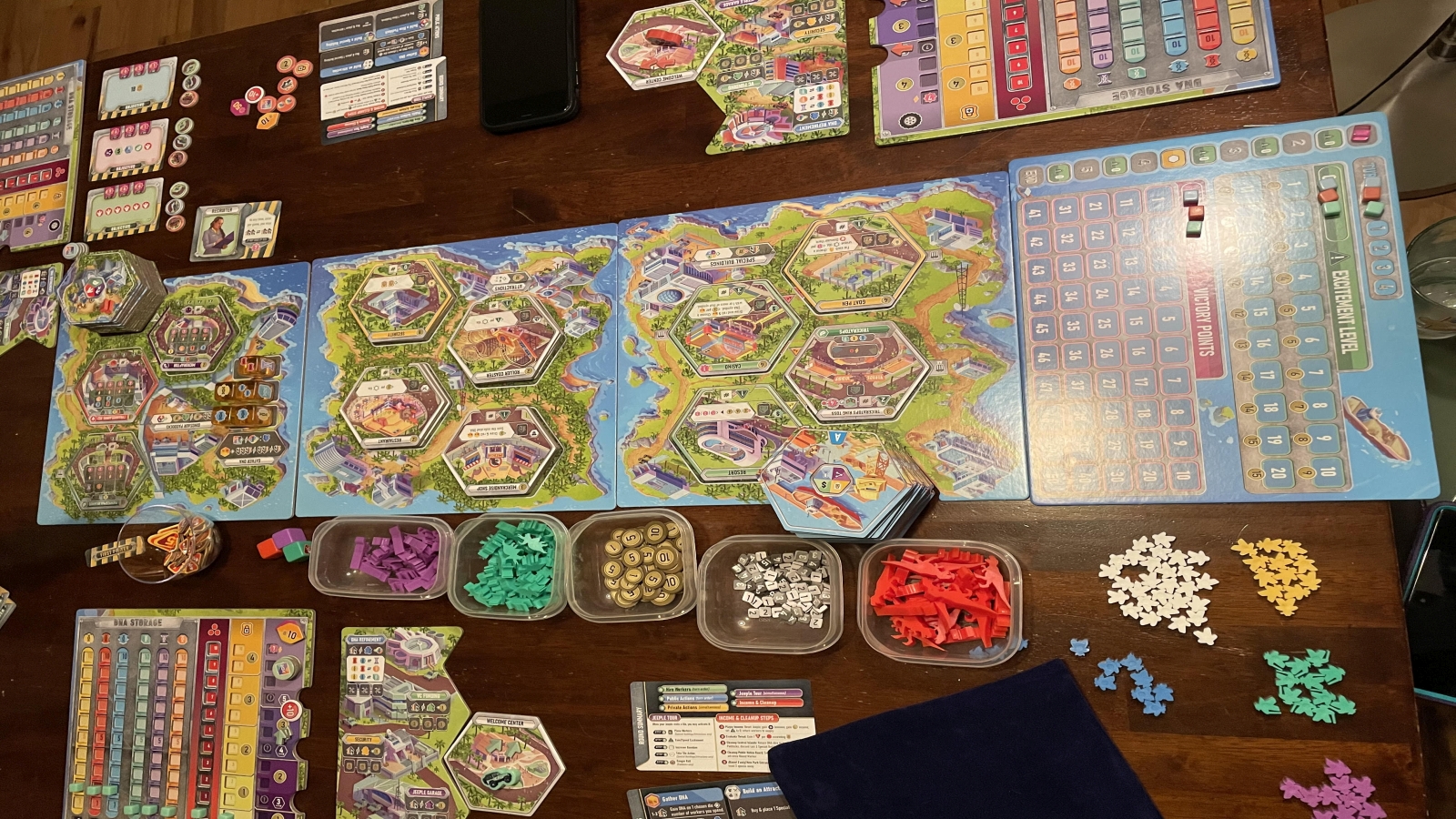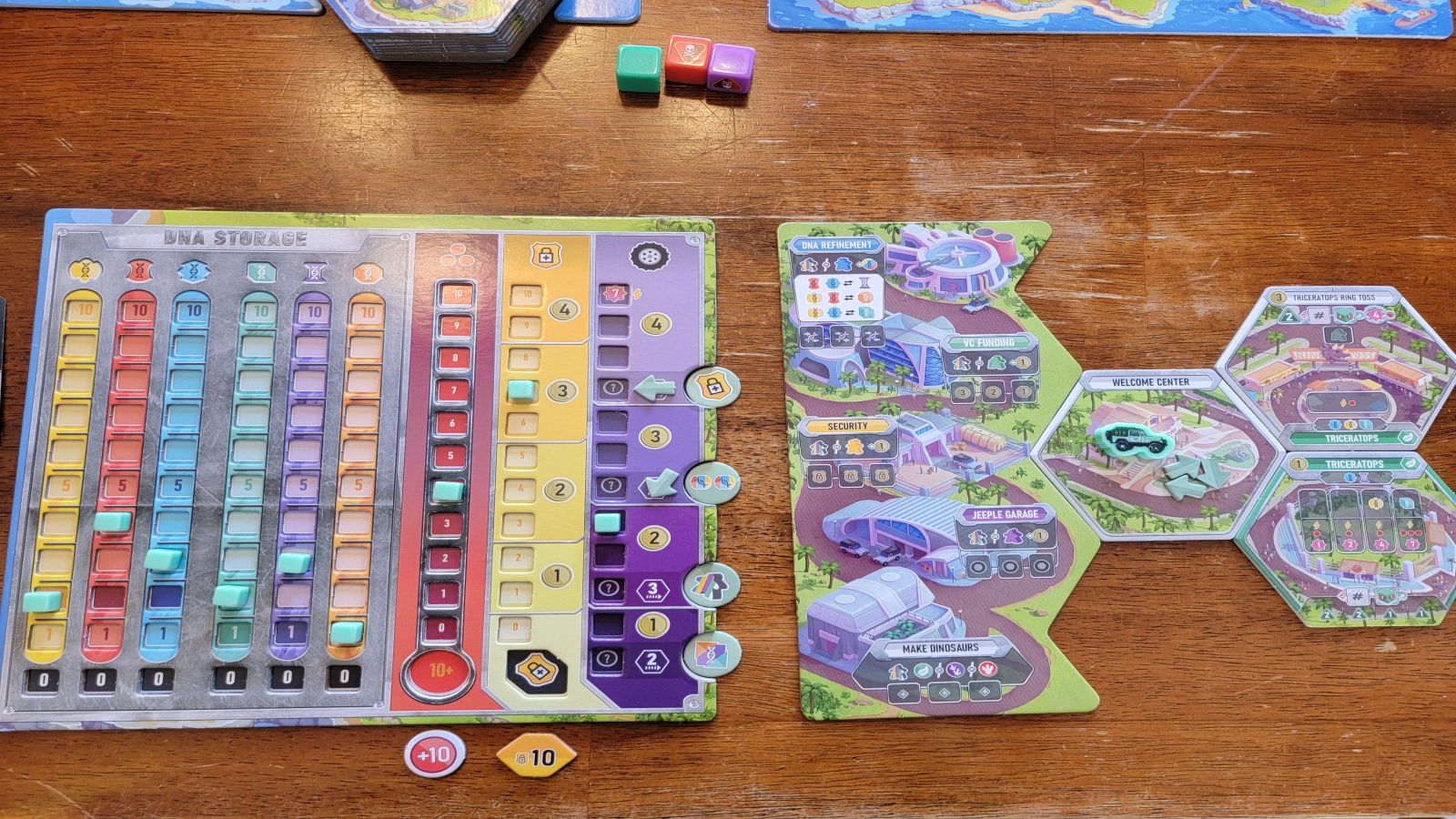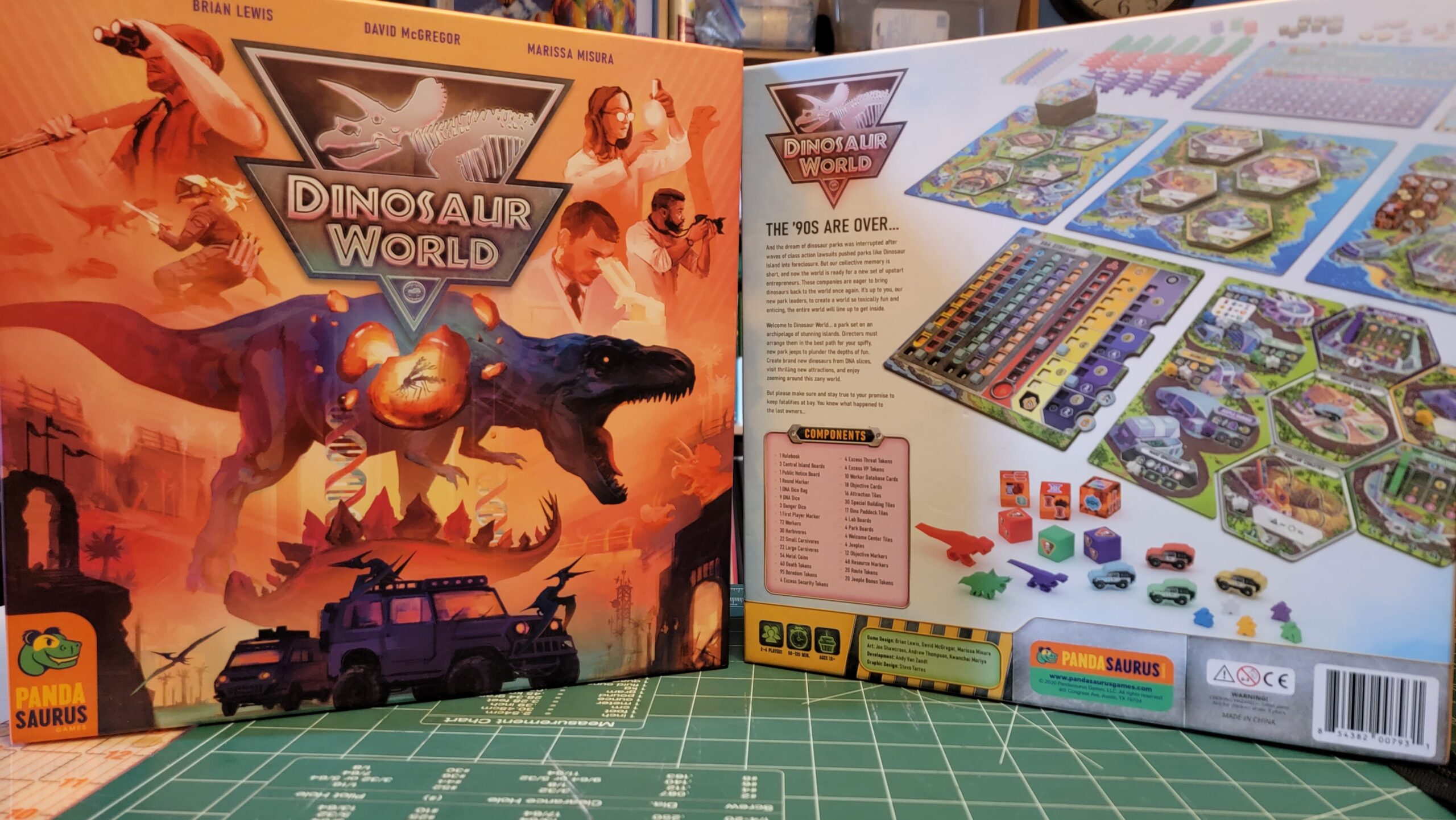85
Welcome to Dinosaur World, a thematic concoction of dinosaurs, dinosaur themed rides and concessions, as well as other buildings and enclosures. Chances are if you like dinosaurs and you like boardgames you are going to find your way to a slew of different games, one of which is the game Dinosaur World by Brian Lewis, David McGregor, Marissa Misura and Pandasaurus Games. While the theme and game have similarities to the previous game in the series Dinosaur Island, rest assured it is a different game. What once started out as an expansion eventually grew too big and became its own standalone game. After a playthrough of Dinosaur World I can wholeheartedly say that moving from an expansion to a standalone game was the right move and Dinosaur World certainly thrives because of it.
Dinosaur World is a medium weight worker placement, tableau building experience that blends elements of the game Suburbia with elements of many other worker placement games. This game makes the focus all about being the best new Dinosaur Park Manager and really excels at rewarding those willing to take risks, but also punishing them for being too risky. With a player count of 2-4 players and an estimated game time of 60-120 minutes, Dinosaur World does not disappoint. Within the game you buy new attractions, acquire different types of DNA, hire workers that excel at different actions, create dinosaurs, and lastly give “Jeeple” tours of your park to determine its viability via excitement and be awarded victory points. Through all these the goal of Dinosaur World is to see whose park is the most successful and the most exciting after 5 rounds.
At the start of the game there is a set of tiles that are the buildings that players ultimately draft from to start their new dinosaur park, so to begin the game players will have a single dino paddock, an attraction, and each player starts with the same “Welcome Center” tiles. Dino paddocks are largely influenced by the different types of dinosaurs you can create on them. green being herbivores, purple being small carnivores, and red being large carnivores. Each time you created a dinosaur from the required DNA you are typically awarded points, herbivores give you the least but are easier to create, small carnivores are slightly harder to create but give a modest amount of points, and large carnivores are the hardest to create but certainly reward you with big points. The question you might ask is why someone wouldn’t go right for large carnivores and that is where threat comes in. In addition to awarding victory points for creating dinosaurs in a paddock, you are also generating threat.

Threat is how the game forces players to make strategic decisions. If your threat is higher than your parks security, then at the end of a round you acquire death tokens for dinosaurs taking advantage of your weak security in your park and having up close and personal visits with your park’s guests. Death tokens award negative points at the end of the game, so while you might have a lot of dinosaurs which has given you a lot of points, you might wind up having too many death tokens taking away a lot of those points.
On the other hand, attraction tiles typically reward you with points, or provide an action that can be taken on your jeeple tour with specified workers. Tiles must be placed next to the Welcome Center and dino paddocks can never touch another paddock. After drafting is all said and done the players move on to the game itself. First players will hire workers, next they will use those workers to take public actions, followed by private actions, then the jeeple tour, and finally income and cleanup.
What winds up being a not so common way to hire workers, winds up being one of the most strategic offerings from the game that can make or break your round as you play. Cards are drawn from the worker database deck equal to the number of players plus 1. In turn order players choose one of the available worker database cards to acquire their workers for the round. Each card has differing unique amounts of the different workers on them while all of them also all have 4 generic workers to be used for most actions. After acquiring your 9 workers from the worker database cards, then players move on to phase 2 of the round, public actions.

During the public actions phase all players get to choose 1 of 4 public actions to take and whether to spend all their workers or save them for private and jeeple tour actions. Public actions include: Gathering DNA, building a Dino Paddock, building an Attraction, and building a Special Building. To gather DNA, you use 1-3 workers and take one of the DNA dice rolled during the round and acquire that much DNA times the amount of workers used. Building an attraction, dino paddock, and special building all require you to spend an amount of money printed on the top of the tiles, and then you place it in your park as long as its next to another tile of yours. After all players have finished taking all the public actions they want and everyone passes play continues to the next phase in the round, private actions.
Private actions are taken simultaneously during the phase. During the private actions phase, each player has their choice of 5 different actions to help create a better park. With different actions such as DNA Refinement, Making Dinosaurs, Jeeple Garage upgrades, Security upgrades, and VC Funding there is no shortage of different strategies players can utilize. With DNA refinement players can manipulate the DNA they have so that creating dinosaurs can be done if they weren’t able to with their DNA they acquired previously. Making Dinosaurs is just that, meeting the DNA requirements from the paddock, create a dinosaur of that type, then you earn points and threat. VC Funding awards money just for visiting the space with a worker, Security upgrades increase the level of security in your park to meet the threat level of the dinosaurs. Lastly, Jeeple Garage upgrades allow you to gain bonuses every round if certain tiers are passed and allow your jeeple to travel further in your park, increasing the excitement you generate which increases the money you earn at the end of a round.
After everyone passes players move on to the Jeeple Tour phase which is also taken simultaneously. Players use the arrows they have and starting at their welcome center travel that to each space an arrow points (at the beginning of the game its 3 spaces total). After a player either uses a space then the same attraction starts to get boring to the park’s visitors and excitement goes down every time an attraction or paddock is visited. This causes income to drop in what is a delicate balance of using attractions sparingly but getting the most out of each different tile placed in your park.
Finally, after everyone has finished their jeeple tour, players move on to income and cleanup. In this phase players check their threat level against their park security and if the threat is higher gain an amount of death tokens equal to the number of steps higher threat is compared to security. However, if players security is higher than their threat, no death tokens are acquired, and that player can rest easy knowing their park is both exciting and safe for visitors. Players then gain income based on the excitement they generated from their jeeple tour, followed by examining the victory point tracker and adjusting player order accordingly (players with more points go later in turn order). Lastly the round marker is moved to indicate the progression of the game.

After 5 rounds are played in Dinosaur World players count how many death tokens they have received throughout the game and the player with the least amount gets rid of their death tokens, and all other players subtract that many from their total. Then points are subtracted based on the amount of death tokens players have and final scores are compared.
After spending some time playing Dinosaur World there are some things that stood out to me and others that feel like they fell a little flat.
Like Dinosaur Island before it, Dinosaur World is a game that does a good job with theme. Many times, during the game it felt like I was a kid again discovering my love for dinosaurs all over again, and this ultimately is what keeps me coming back to games. The rounds take a little more time than estimated but the extra time is welcome, especially when playing with friends. Large Carnivores might wind up being the only thing that cause me any concern in the game. That being said, large carnivores are not the only strategy that works for winning, just how the game I played of it turned out.
Dinosaur World is a love letter to anyone who has a love for dinosaurs. It is certainly not a quick game that’s meant to be played in an hour, it’s more of a marathon where the players pace themselves. Teaching Dinosaur World seems more daunting than it is as everything is explained concisely, allowing more in-depth questions to be found out through further detail in the rulebook. While I enjoy a lot of games that fall into light weight games for their simple rules and quick games and ability to be a gateway game, Dinosaur World is most assuredly a medium weight game for those like myself that enjoy strategy and meatier games. With box art that is a cut above the rest, making shelf space for Dinosaur World is a welcome experience and one that anyone who has a love of board games and dinosaurs will enjoy immensely.
Pros
- Good medium weight game with an excellent theme.
- Game pieces and boards are beautiful and provide lots of visual stimulation
- Solid balance in point scoring throughout the game.
Cons
- Players that took risks with Large Carnivores seemed to gain points and have threat and cost not really slow them down much. (Balancing)
- Inclusion of some more Worker Database cards would be welcome.
- Expanding the base game to be a 2-5 player game instead of capping at 4 players.
- First Player token is easily forgettable and buying a small dinosaur figure from the dollar store lends itself to the game more appropriately.
Score 85/100
Overview
Information Accuracy 9/10
Innovative Concepts 7/10
Engaging Mechanisms 8/10
24/30
Components
Artistic Theme 8/10
Materials – Quality/Durability 4/5
Storage/Unboxing 5/5
17/20
Gameplay
Player Scalability 8/10
Mastery Ceiling 28/30
Replay Value 8/10

